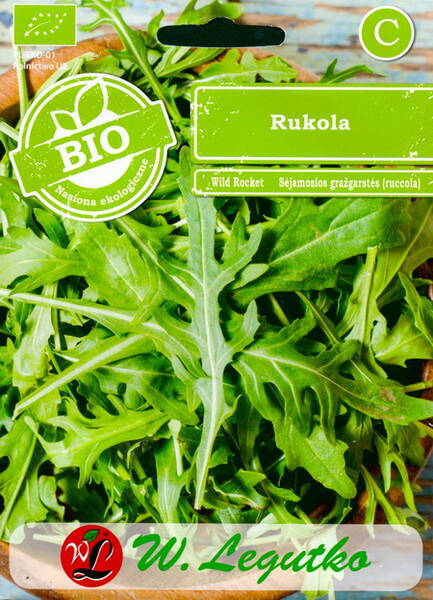Wild Arugula is a perennial plant that is a rich source of vitamin C, iron, essential oils and mineral salts. Used in salads, pastas and sandwiches. The seeds come from organic farming. They have been produced naturally without the use of chemicals or artificial fertilizers, in accordance with EU standards. Natural product - does not contain GMO seeds.
This is a "relative" of the Indau arugula, an unpretentious cold-resistant perennial about 30-40 cm high, with a branchy, woody stem at the base.
The leaves are oblong, pinnately dissected, with a mustard-nut flavour, more pronounced than that of the Indau. The aroma is also more intense.
Greens are rich in carotene, B vitamins, iodine, ascorbic acid, fresh consumption increases the level of haemoglobin in the blood and promotes the elimination of "bad" cholesterol.
Sowing directly into the open ground from mid-April to a depth of 0.5 cm. Seedlings appear on the 5-7th day. The culture supplies fresh greens from May to October.
Remove peduncles regularly if you do not plan on receiving seeds.
It develops well on light-neutral soils without excess organic matter under solar exposure.
.jpg)
Eng.: Perennial Wallrocket, Sand Mustard, Sand Rocket. Deu.: Wilde Rauke. Bot. syn.: Rucola sylvatica.
Even in ancient Rome, rucola was a popular herb and was used as a tonic. The sour-tart leaves work well with other leafy vegetables and are used in salads and stewed vegetable side dishes along with spinach.
Arugula is added to creamy sauces for pasta dishes. Arugula is now widely used in Mediterranean cuisine. For example, in Italy rucola leaves are added to salads, pasta dishes, pizza, risotto. Arugula can be used in place of basil in pesto sauce. It has a pronounced aroma and a pungent mustard-nutty flavor. Arugula seed oil is also used in cooking. It is added when canning vegetables.
Very unpretentious and resistant to cold weather. In Italy it can be grown all year round, but in the Nordic countries it can be planted primarily and directly in open ground. The more you pinch it, the better it grows. In the morning we cut off the petals, and in the evening new ones grow ...
She is the first to "ripen" and go to salads with tomatoes, radishes and leaves of a still very young salad.
At a temperature of + 18 + 20 degrees, single shoots appear on the 2-3rd, and massive ones on the 5th day. With April - May sowing dates, harvesting ripeness occurs on the 27th-35th day from the emergence of mass shoots.
Arugula can be effectively grown both in open and protected ground by sowing seeds in a permanent place or by planting seedlings. The seedling method allows you to economically use seeds and get an earlier and higher yield. Seeds are sown or seedlings are planted with row spacing of 30-40 cm, in a row between plants 10-15 cm. A denser placement of plants is possible if timely thinning is carried out, which usually occurs when sowing with seeds.












